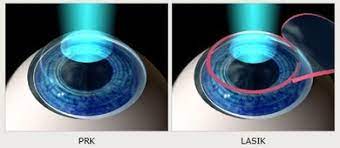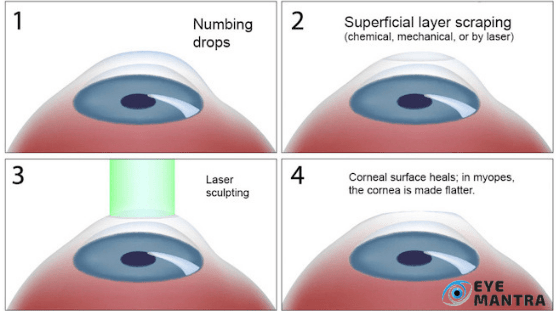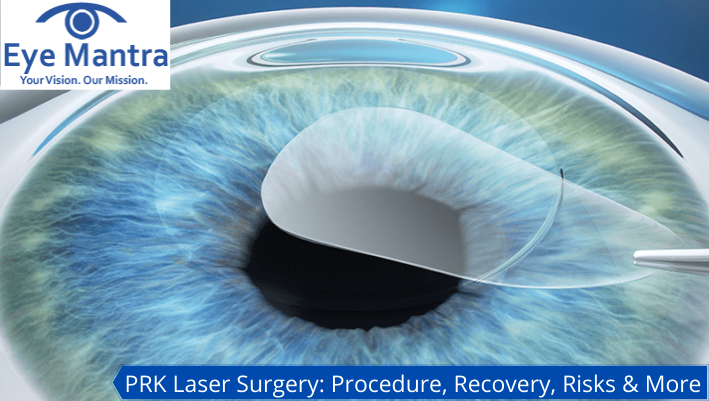Contents
- 1 What Is Photorefractive Keratectomy (PRK)?
- 2 PRK vs Lasik Surgery
- 3 Requirements For PRK Surgery
- 4 Who Should Not Get PRK?
- 5 Benefits of PRK Surgery
- 6 Before PRK Surgery
- 7 Do’s before PRK Surgery
- 8 Process of PRK Laser Surgery
- 9 Recovery From Laser Surgery
- 10 Vision After Photorefractive Keratectomy (PRK)
- 11 Risks Involved In PRK Laser Surgery
What Is Photorefractive Keratectomy (PRK)?
Photorefractive Keratectomy or PRK is a type of laser surgery to treat refractive errors. It is performed to correct vision problems. The refractive error is when your eye does not refract (bend) light properly.
There are several different surgical techniques used to reshape the cornea, the clear front part in the anatomy of the eye. All vision correction surgeries using laser, work on changing the contours of your cornea. This way the light traveling through it gets properly focused onto the retina located in the back of the eye. There are many different surgical techniques used to reshape the cornea.
PRK is used to treat myopia (nearsightedness), hyperopia (farsightedness), and astigmatism with laser surgery. PRK laser surgery is performed to correct your refractive error to improve your eyesight and vision. It is a kind of Specs Removal surgery, as it may reduce or even eliminate your need for eyeglasses or contact lenses.
PRK vs Lasik Surgery
With PRK laser surgery, your Eye Doctor uses a laser to change the shape of your cornea. This pulsing beam of ultraviolet light is used on the surface of the cornea, not underneath a corneal flap as in LASIK. The laser changes the shape of your cornea. This improves the way how light rays get focused on the retina. Light travels through the cornea and focuses on the retina at the back of your eye. On the other hand, LASIK, another type of laser surgery, works underneath your corneal flap.
If you suffer from Dry Eyes or thin corneas and want to have refractive surgery, PRK would be a good choice for you. This is because LASIK Surgery is not recommended because it can lead to dampening the cornea sensitivity and cause Dry Eye Syndrome.
Also, if you have a very active lifestyle or are working, PRK may be a better option for you than LASIK or other such procedures. The reason for this is that PRK laser surgery does not involve cutting a flap in your corneas like LASIK, and others. If you are highly active, the corneal flap could get accidentally dislodged, causing problems.

Requirements For PRK Surgery
- 18 years or older (ideally, over 21 years old. Because, by then, the vision is more likely to have stopped changing).
- Your eye prescription has not changed in the past year.
- The refractive error in your eye must be one that can be treated with PRK.
- The cornea is healthy, and your overall eye health is generally good.
Who Should Not Get PRK?
PRK laser surgery is not advised for certain patients who have:
- An uncertain (changing) refractive error
- Skin or other diseases that can affect healing
- History of a lot of scarring
- Corneal abrasions or disease
- Glaucoma of advanced stages
- Cataracts affecting vision
- Diabetes and sugar out of control & check
- Female who is pregnant or nursing
- A history of eye infections.
Benefits of PRK Surgery
PRK has enabled millions of people with myopia or hyperopia, by Specs Removal surgery, to achieve independence from eyeglasses or lenses. The procedure has low complication rates, and the result is quite predictable, i.e. treatment of low refractive errors.
- PRK can perfectly correct Hyperopia (nearsightedness). Approximately 90% of patients, after PRK laser surgery, have a 6 by 6 vision and do not require glasses or contact lenses one year after the surgery. Over 95% feel they can work, and do not need to wear glasses or contacts.
- PRK may be preferable to LASIK in certain patients who have thinner corneas or irregular corneal surfaces because PRK disrupts less corneal tissue as compared to LASIK surgery.
- Technically PRK is far simpler than LASIK. While using the same modern laser treatment systems.
- Patients who have artificial lenses put in their eyes during cataract surgery may have PRK to improve their vision.
- Because no corneal flap is created, eye surgeons and patients do not have to worry about any complications occurring in the flap, later.
Before PRK Surgery
Pachymetry is used to ascertain the thickness of your cornea. You and your Eye Doctor will discuss your needs based on your lifestyle. For example, if you are into sports, you may be looking for clear-distance vision from surgery. Therefore, it is important to discuss your expectations for PRK.
People who have PRK and expect to achieve perfect vision without glasses or contacts run the risk of being disappointed. PRK laser surgery allows people to do most of their everyday tasks without corrective lenses. However, you might need to wear glasses for some activities, such as reading or driving at night.
Your eye surgeon will thoroughly examine your eyes, and make sure you are the right candidate for PRK. Or your Eye Doctor would explain to you about other eye diseases that may keep you from having PRK.
Do’s before PRK Surgery
- The overall health of your eyes will be checked.
- Test your vision to make sure that your vision has not changed. It also shows how high the refractive error is and whether PRK should be used to correct your vision.
- Your ophthalmologist will make sure that you do not have any other eye problems. This is because other problems would affect or complicate your surgery. Or PRK laser surgery could make those other problems worse.
- Your ophthalmologist will measure, and map the surface of your cornea. She will check its thickness and make precise measurements of the cornea’s surface. Then, she will use these measurements to program the computer-based laser used during surgery.
- She will also measure the size of your pupil.
Process of PRK Laser Surgery

Photorefractive Keratectomy (PRK laser Surgery process)
PRK surgery is usually performed in an outpatient surgery center. The procedure takes about 15 minutes, usually. Here is the process:
- Your eye will be locally anaesthetized using eye drops.
- An eyelid holder will be placed on your eye to keep you from blinking.
- Then the outer layer of cells on your cornea, called the epithelium, will be removed. To do this, a special brush, blade, laser, or alcohol solution may be used.
- You will be asked to stare at a point of light so that the eyes do not move.
- Now, the laser is used to reshape the cornea. The laser comes from a special instrument that has been programmed with measurements for your eye.
Recovery From Laser Surgery
Right after surgery, a “bandage” contact lens will be placed over the eye to help it heal.
- You will need to have someone take you home after the surgery. You should, ideally, stay home, and take a rest after the surgery.
- It will be suggested to take a few days off from your work. Also, you should avoid strenuous activity for up to 7-10 days after the surgery, as this could slow the healing process.
- For 2-3 days after PRK, you may have some eye pain. Over-the-counter medicine usually controls the pain. Seldom, some people may need prescription pain reliever eye drops or other medicine to relieve pain. Do ask your Eye Doctor if your pain doesn’t go away with over-the-counter medicines.
- You will need to use eye drops for up to 1 month or as prescribed by your ophthalmologist. Be sure to follow the doctor’s instructions for using this medicine to help the healing process.
- After PRK, you will need to wear sunglasses outside for as long as your doctor prescribes. This is because exposure to sunray and UV rays can lead to corneal scarring after surgery, causing vision problems.
At first, you will experience Blurred Vision, after PRK. Over the next 3–5 days, as you heal, the vision will gradually improve. It, normally, takes a month or longer to achieve your best vision.
Vision After Photorefractive Keratectomy (PRK)
About 90% of people who have PRK end up with 6 by 6 vision or better without glasses or contact lenses.
It is important to know that PRK cannot correct Presbyopia. This is the normal, age-related loss of vision in seeing close objects. Almost everyone who has excellent distance vision will need reading glasses after around age 40, with or without refractive surgery.
To help with presbyopia, some people have PRK, first, to get monovision. In other words, one eye is left slightly nearsighted, and the other eye is adjusted for distance vision. Our brain modifies so that the nearsighted eye is used for close work, while the other eye sees distant objects. Monovision is not recommended for everyone. To see if you can adapt to this correction, you should ask to try monovision with contact lenses first.
Risks Involved In PRK Laser Surgery
Like all other surgeries, PRK carries risks of problems or complications you should consider. These include:
- Glare, and halos around lights (especially at night)
- The cornea getting scarred
- Corneal haze or the cloudiness of the cornea
- Corneal infection
Also, your vision may end up being under-corrected or overcorrected. Most of these problems can be improved with glasses, contact lenses, or additional laser surgery.
And can be treated without any loss of vision. However, very rare problems may be:
- Having worse vision than before, even with glasses or contacts (called loss of best-corrected vision)
- Blindness
If you are not uncomfortable with wearing contacts or glasses, you may not need refractive surgery. You and your ophthalmologist, together, can weigh the risks, and rewards of PRK.
It’s suggested to get your eyes treated with the best eye hospital in Delhi. It’s suggested to get your eyes treated with EyeMantra. PRK Laser surgery is not painful, and it just takes a few minutes. Still the procedure needs precision, experience, using the latest technologies, equipment, hygiene, and complete focus of the eye surgeon. Therefore, EyeMantra is recommended.
Call +91 9711115191. Now to book an appointment. Or mail at [email protected].
We also offer various services like Retina Surgery, Cataract Surgery, Glaucoma Surgery , and much more.



